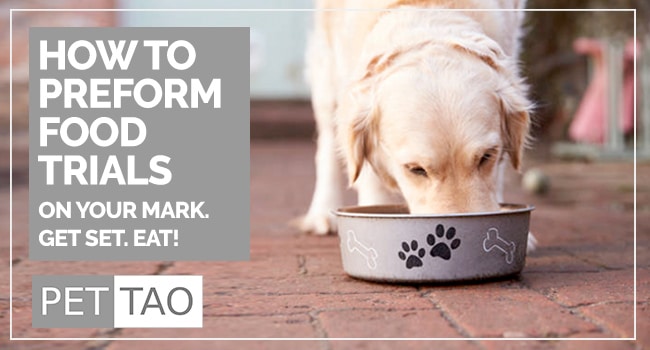Over the past four weeks, though, Fluffy has started to itch and show dog food allergy symptoms.
Pondering the thought that the itching could be due to diet, Mrs. Jones, based on advice from the pet store employee, changes Fluffy’s diet.
Fluffy now:
- Is now eating the filet mignon of dog food, a raw diet.
- Certainly enjoys the new diet.
- Even has a new spark in her eyes; however, her itching persists.
Mrs. Jones gets frustrated and feels sorry for Fluffy.
She wants to help but doesn’t know what to do.
How to Confirm Dog Food Allergies
Diet trials with a hypoallergenic dog food are the only way to diagnose dog food intolerance or food allergies in dogs.
The most common ingredients that cause allergies are, actually, the ingredients to which dogs are most commonly exposed.
Beef, chicken, corn, and dairy products, being the most common protein sources in commercially prepared pet food, are most commonly implicated as food allergens.
Just as Mrs. Jones learned, arbitrarily choosing a pet food based on conjecture, anecdote, or hearsay is unwise, expensive, and often disappointing.
For this reason, a diet trial should be pursued in all dogs with non-seasonal signs of dog allergies and/or ear infections.
How to Perform the Trial
- Feed a novel protein or hydrolyzed protein diet exclusively for a minimum of 8 weeks. A novel protein diet contains a protein source foreign to your dog’s immune system. Likewise, a hydrolyzed diet is a diet that contains chemically digested protein particles unrecognizable by your dog’s immune system. Both of these types of diets are hypoallergenic.
- Feed only the novel protein or hydrolyzed diet and approved treats throughout the entire length of the diet trial.
- Feed a home cooked diet that meets the basic recommendations regarding protein, fats, carbohydrates, vitamins, and minerals.
Within 6-8 weeks expect to see improvement in food allergy symptoms, and up to 12 weeks to see complete resolution of signs.
What Happens if We Accidentally “Break” the Diet?
If a “break” in the diet should occur, the diet trial should be extended to allow adequate time for the signs associated with food allergy to subside (2-8 weeks).
If clinical signs of allergic dermatitis resolve during the hypoallergenic diet trial, ideally, the patient should be re-challenged with their original diet to confirm the improvement was related to the hypoallergenic diet.
But, if after resuming the original diet, the patient has a reaction or flare up, other options are available. The veterinarian may continue the patient on the hypoallergenic diet indefinitely or challenge the patient with individual ingredients in the original diet to determine the offending allergen(s).
Recognizing Food Allergen Reactions
If an allergic reaction is going to occur to a food allergen, it typically occurs within 24 to 72 hours following exposure to the allergen.
However, a reaction can occur up to 2 weeks following exposure.
Therefore, individual ingredients or new diets should be fed for 2 weeks while closely monitoring the patients for any recurrence of their food allergy signs.
When individual ingredients are added to the diet, they should be added in small amounts, monitoring closely for any changes in clinical signs.
If a food allergy flare should occur, the patient should be returned to the strict hypoallergenic diet until all clinical signs resolve.
What To Do for A Flare Up
Typically, signs associated with a food allergy flare will resolve over a two-week period if the flare-up is mild and no secondary infections occur.
Antihistamine therapy may be administered for mild food allergy flares, whereas more severe flares will require an anti-inflammatory course of glucocorticoids (ie, prednisone, prednisolone).
Whether or not you re-challenge your dog with the original diet is totally up to you.
As a general rule, I frown upon re-challenging your dog.
Treats: The Pitfalls of a Successful Hypoallergenic Diet Trial
Everyone enjoys giving treats to their beloved dog.
However, realize that just one bite of an allergic treat can cause a continuation of the allergy signs.
Pick treats with caution and in the same manner that you choose diet.
Choose treats that are labeled hypoallergenic or that originate from single, novel protein sources such as pork, venison, or lamb.
Fruits are unlikely to be allergenic in dogs and therefore are a good option.
Vegetarian hypoallergenic treats are also another good option.
Milk-bones, rawhides, and other table scraps should be strictly avoided throughout the length of the diet trial.
Unfortunately, some dogs will frequently have both food allergy and atopy and control of both conditions is necessary.
More Powerful Tools for Overcoming Dog Allergies
There are many quick and easy changes you can make at home to help give your dog an edge on easing allergy challenges.
- Learn more about managing dog allergies.
- Switch to a Limited Ingredient Diet. PET | TAO Limited Ingredient Diet is naturally low in foods that stimulate an allergic response.
- Supplement with medicinal mushrooms. PET | TAO Complement Immune Mushroom Blend eases inflammatory response and allergy symptoms.
- Try digestive enzymes and probiotics. PET | TAO Harmonize Gi boosts gut health and combats food allergens.
- Feed Freeze Dried Lung Treats. According to TCVM, Lung is on the same meridian as the skin. Therefore, lung treats help both breathing and skin allergies. Lung treats support lung and skin similar to a glandular supplement in a “like treats like” fashion.
- Learn more about TCVM Herbal Remedies. Chinese medicine offers many amazing natural solutions for managing dog allergies Some good examples are:








